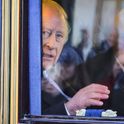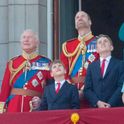“If you’re explaining, you’re losing” is a political maxim popularised by Ronald Reagan. The adage has been attributed to political pundit George Will, and refers to how any politician who finds themselves explaining will often already be on the back foot, and will most likely be confusing and losing their audience.
Like hundreds of millions of people watching the coronation, I found myself caught up in a complex web of sentiment. The music was beautiful, and in places was spine-tingling. Slow-paced stately grandeur is an aesthetic, but also a kind of politics. The appearance of progress—on the day and over time—comes through small but welcome advances. Nods to modernity pepper the occasion. But appearances are all it is.
The presence of other faith leaders, and the visual complexion of the event (far less ermine, and welcome representatives of civic, social and charitable causes) reminded us of how much Britain has changed. Greater ethnic diversity better reflected contemporary society. The lengthy back-catalogue of Conservative prime ministers inevitably provided a silent comment on the state of the nation.
Newly commissioned music spanned from aria and anthem to a gospel choir. You could say that the bandwidth of the coronation service moved effortlessly through a repertoire of fare to suit audiences from Radio 2, 3 and 4, bracketed by pre- and post-processional commentary that was more in tune with Radio 5 Live. As national liturgies go, this one seemed to tick every box, and could be safely chalked up as a triumph.
Yet my reaction was tempered with profound unease. Britain is not secularised, but it is spiritually and religiously diffuse. Faith finds itself poured out and spread thinly across society. Religious salience and affiliation are nothing like as powerful as they were during the last coronation, 70 years ago.
In the run-up to this coronation, consistent surveys and polls showed little appetite for the event among the under-30s. Along with other religiously disaffiliated sections of society (which now cover more than 50 per cent of us), very few among the emerging generation turned to religion or spirituality for support through the trials of the pandemic and the country’s current economic tribulations. Instead, they have found more dependable comfort in material and social and familial palliatives.
Coronations have previously been occasions for national and spiritual renewal. What we were served with on Saturday was a kind of cake (or perhaps coronation quiche), made with the ingredients of nostalgia and paternal sincerity, baked together with quirky pageantry and atypical liturgy. For some, this was a banquet to savour. For others, it resembled the proverbial curate’s egg.
The dissonances the coronation service could not overcome were rooted in the symbols and words that can only have any meaning if carefully explained and pleaded. Without the lengthy elucidations, we—the subjects—would be left to puzzle over the point of the objects. To be sure, Penny Mordaunt’s sword-bearing has already become the stuff of legend. But what did the sword symbolise?
The golden sword only dates back to King George IV's coronation in 1821. It is entrusted to the monarch upon the order that “it should be used for the protection of good and the punishment of evil”. So, a symbol of defence, but also attack; protection, but also assault. The bearing of the sword is unavoidably linked to the armed forces—present in large numbers at the coronation—with the powers of state coercion and lethal force also affirmed in the symbolism. (One can imagine the media brouhaha if a president of the US was inaugurated holding a bible in their left hand and a Magnum revolver in their right.)
Explanations for the symbols appeared in the liturgy, the pre-coronation PR warm-up and the media commentary for the day. One could jest about the orb, sceptre, robes, glove, spurs and other “ancient” artefacts. But I suppose it was better than having cufflinks of conformity, a tiepin of togetherness or shoe buckles of sobriety. Symbols have to mean something: more than the sum of the token or object. As eminent sociologists Émile Durkheim and Edward Shils observed, national symbols are a kind of currency, and their value depends taking their meaning on trust. But if you are explaining your symbols, you are already acknowledging their receding value. Moreover, as these explanations become increasingly remote from the lives of most people, the risk of loss of meaning, value, form and function looms larger.
The coronation of Charles III was an opportunity to read the sign of the times and present the United Kingdom with a more holistic vision for the monarchy, society, the people and the world. Greater sensitivity to religious diversity added some granularity and complexity, but, alas, the Church of England still retained a virtual monopoly over the event, ensuring that what came through any superficial nod to other faiths was a determination, through clenched teeth, to assert that Anglicanism was still the Top Denomination in the land.
This grated with many onlookers. There were far too many male bishops with high visibility, yet minimal functional or even symbolic tasks in the coronation. The PR attempted to detract from this by inviting us to marvel at the presence of women bishops as some kind of breakthrough moment and marvel for modernity. Yet the Church of England remains aloof from modern social norms, with exemptions under the Equality Act permitting it to discriminate in ways other institutions cannot.
Handel’s haunting “Zadok the Priest” would have given even the most hardened atheist goosebumps. Yet we forget that the anointing of Solomon (I Kings, chapter one) was conducted by Zadok and Nathan the prophet. The act of making a king for Israel was performed by a hereditary priest and a non-hereditary prophet. Yet the coronation liturgy has almost eliminated the role of the prophetic. This leaves us with a ritual celebrating theocratic power, but without its necessary prophetic challenge.
“No Zadok without Nathan” might have made a pretty decent crowd chant on the day of the coronation, though its pointedness would be lost on most. Thus, the liturgy gave us far too many bishops and priests, but few prophets anywhere in sight. Perhaps—and it is a stretch to suggest this—the prophet of climate action and ecological concern was the one being anointed and crowned?
Yet the anointing of a monarch is done once, and once only. Prophecy, in contrast, is a thankless daily task and lifelong vocation. The function of prophets in the Old Testament was to keep rulers honest and accountable, and call them out when they failed the people and God. Prophets were raised up to level-down the rulers.
In David Nicholls’s Deity and Domination (1989) he discusses how notions of dominion, majesty and might in the secular-public sphere are still theologically-freighted. Imagery, symbols, words, roles, offices and rituals combine to reinforce hierarchical patterns of dominion, in which the state appeals to God for legitimacy in hegemony. King, Lord, Judge—the monarch and Church of England bishops combine all three—make it possible for theocratic and theological constructions of reality to impose themselves on civil society.
One of the subtlest self-deceptions practised by those who exercise power is believing they are always acting in others’ best interests. This explains how the monarch claims to be the servant of the people, and yet also the ruler. This is where the subjects and objects are confusing. The true symbols of Christian kingship were a basin and towel (consider John 13 and Jesus washing the feet of others) not a sceptre and orb; a crown of thorns, not of jewels; a cross to carry, not a coach for your carriage.
Serving the people through symbolism, and even taking up particular causes, can easily become a means of maintaining patrimony and power. The coronation ritual was one of scintillating splendour—dazzling and deifying. Yet despite the enchantment, the ritual remains opaque. The density of the liturgy is impenetrable to the vast majority of the public, and that risks rendering the whole event as incomprehensible. Unlike 1953, the 2023 coronation probably fails as an effective public ritual. If those watching the coronation need to have everything explained, and can no longer make affective and effective connections between words, rituals and symbolic actions, then the freighted weight of religious meaning is no longer understood. Too much is lost in translation. Those explaining it are losing.
Next time—assuming there is a next time—ushering in a new reign could be achieved more simply. The monarch could pledge a civic oath of allegiance and service to parliament and the people in the Great Hall of Westminster, before being consecrated in a religious service at Westminster Abbey. This would not require a Eucharist. The symbols of monarchical power—military and sacred—could be blessed on the high altar, but vesting would not be necessary.
For all the liturgical and ritualistic camouflage provided by the coronation, it is not hard to see the failings. Even the briefest touching of the bread and wine by Charles III before the Eucharist provides confirmation of the sacramental status the monarch now assumes. Anointed, consecrated, vested in a stole which he wears as a priest or bishop might, the symbolism is all there to emphasise Charles’s royal priesthood.
Churches and denominations typically resist change because they lack a vision for the future of society, and can only anticipate any change to rituals as yet another further step in diminution, dilution and marginalisation. The residue of deference also plays a part, and it becomes too easy to repeat the past rather than map out some better future.
What we witnessed in the 2023 coronation was a few modern ingredients sprinkled into an old recipe. In so doing, vested interests and establishment power were curated through a submission to precedent, tradition, nostalgia, pageantry and ritual—and all executed with military precision. In all this, the subjects and objects were misplaced, and an opportunity lost.
The truth is that new rituals would better encapsulate our hopes—with words and symbols that offer a narrative for the monarch and people moving forward together in the 21st century. Instead, the 2023 coronation chose to look backwards. May it be remembered as the last one to do so.













